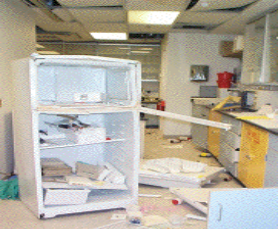Refrigeration/Freezing of Flammable Liquids
Flammable liquids must never be stored in standard domestic refrigerators, freezers, or cold rooms
- Vapors from the stored chemicals can accumulate over time and come in contact with an electrical spark, thus creating a powerful explosion
- Sparks can occur with normal operations of these appliances such as when a thermostat, defrost timer, internal lighting unit, or the motor turns on and off
- Even a small quantity of flammable liquid stored in a non-approved refrigerator or freezer can cause a large explosion
- Explosions, injuries, and costly laboratory fires have resulted from storing flammable liquids in domestic refrigerators or freezers
|
| University of Vermont: Flammable liquids stored in a refrigerator resulted in an explosion |
|
| University of Virginia: A thermostat spark ignited flammable vapors |
Flammable material refrigerators and explosion-proof refrigerators are designed to prevent ignition of flammable vapors and can be used for storage of flammable liquids
- A flammable liquid is defined by OSHA 1910.1200 App B Physical Criteria as having a flash point of not more than 93 °C (199.4 °F).
- Review the Safety Data Sheet (SDS) for the flash point of liquids
- Flammable-safe refrigerators will be U.L. listed, and bear a label stating "FLAMMABLE STORAGE - KEEP FIRE AWAY"
- Explosion-proof refrigerators are constructed so that there are no sparks or static charges generated either inside or outside of the unit
- These refrigerators are typically used in specialized locations such as solvent dispensing rooms
- Avoid storing flammable liquids with strong oxidizers or acids and provide suitable secondary containment
- Chill flammable liquids in an ice bucket prior to use rather than storing them in a standard domestic refrigerator
COMMON LABORATORY SOLVENTS
Do not store these flammable liquids in standard domestic refrigerators
| Chemical | Flash Point (°F) | Chemical | Flash Point (°F) |
|---|---|---|---|
| Acetone | 4 | Isopropanol | 53 |
| Acetonitrile | 42 | Methanol | 54 |
| Benzene | 12.2 | Petroleum Ether | 20 |
| Butanol | 84 | Propyl Alcohol | 74 |
| Cyclohexene | 10 | Pyridine | 68 |
| Dioxane | 54 | Tetrahydrofuran | 6 |
| Ethyl Acetate | 24 | Tetramethylethylenediamine | 50 |
| Ethyl Alcohol | 55 | Toluene | 40 |
| Ethyl Alcohol (20%) | 97 | Triethylamine | 20 |
| Ethyl Ether | -49 | Xylene | 84 |
| Hexane | -7 | 2-Methylbutane | -60 |

